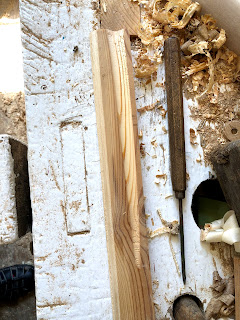The first parcel is a mixed set of plough irons from good british manufacturers I bought on ebay.co.uk for pocket change... it contains a few J Howarth, Sorby, Marples, Varvil. J Howarth is quickly becoming a favourite tool maker of mine. I now have 2 infill planes (a smoothing plane and a shoulder plane) with his irons and they are really nice to use. The plough iron set has duplicates (1,2,9) and is missing a #6. Fortunately I had a #6 from IL&S that came with a wooden plough I bought years ago. I got lucky and the entire set does fit in one of the two wooden ploughs I bought in Germany years ago. The tool roll is quite tired, but it will serve as a pattern to make its replacement. I've ordered a 1m x 1m60 length of heavy canvas for that purpose.
I will sharpen them shortly on my Scheppach Tiger 3000 VS (a cheap German clone of Tormek I bought a couple of months back). I will first need to make a jig to ensure that the business end is square to the wheel surface as the tangs are tapering on both axis. This means I can't rely on the built-in square of the tool holder.
The next parcel is a present from my friend Brian at Toolerable. It was a heavy parcel, just shy of 10 pounds.
I had to wait until I got home at the end of the day to have a better look at the inside of the parcel:
It's a set of German-engineered dowel plates, covering from 3mm to 20mm. This is awesome as I was looking at crafting my own for round tenons. I've already tested it by knocking in a bit of 8mm dowel I bought from a big box shop and it quickly adjusted it to true 8mm diameter. I will need to try it further with various bits of straight-grain wood. Here's a video of Elia Bizzarri showing how dowel plates are used for tenon work.
Thanks a million Brian! They'll be put to good use!


















































